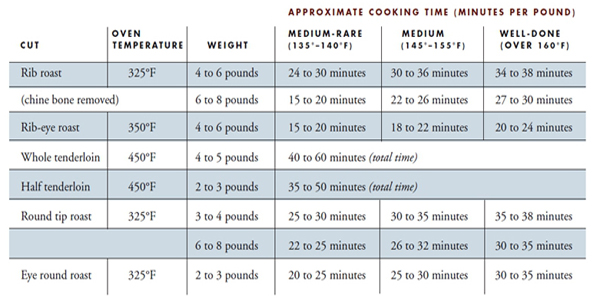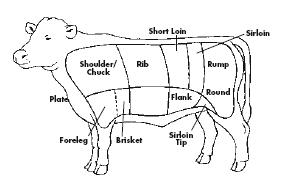4
MEAT
Meat is the major source of protein in the American diet, so it is important to know how to choose it and cook it properly.
BUYING MEAT
All meat in the United States is inspected by the United States Department of Agriculture (USDA) to ensure that it is safe to eat and free of disease, although some diseases, such as E. coli and salmonella, cannot be detected by the naked eye.
Grading is a voluntary procedure, and the grade given to any particular piece of meat reflects its tenderness: The higher the grade, the more tender the meat. There are different criteria for grading beef, lamb, and veal. In general, meat is graded according to age (the older the animal, the tougher the flesh) and the amount of marbling (streaks or flecks of fat within the flesh). This internal fat melts into the meat during the cooking process, moistening and flavoring the meat; the external fat that surrounds chops and steaks can be trimmed away.
The meat available to consumers is graded prime, choice, and select or good. Beef has the largest number of grading levels because the degree of tenderness varies much more from cut to cut. Lamb is also graded but veal only occasionally. Pork is rarely graded because only the highest grade is sold to consumers. One good bit of advice: Always buy the highest grade of meat you can afford.
STORING MEAT
Always store raw meat in the coldest part of the refrigerator (usually the bottom shelf), away from cooked and ready-to-eat foods. Place the meat on a plate or tray to catch any drips. Refrigerate uncooked meat for up to two days or freeze for up to six months. Ground meat can be refrigerated for one or two days or frozen for up to three months.
For short-term storage (up to two days in the refrigerator or up to two weeks in the freezer), leave raw meat in its original store wrapping. For longer freezing, or if the wrapping is torn, carefully rewrap the meat in freezer wrap or heavy-duty foil, pressing out all the air. Stack steaks, chops, and patties between sheets of freezer paper before wrapping. Label each package with the name of the cut, the number of servings, and the date.
Thaw frozen meat, on a plate to catch any drips, overnight in the refrigerator, not at room temperature. Do not refreeze uncooked meat or the texture will suffer. And for best results, do not freeze meat, raw or cooked, for longer than three months. Large roasts, however, can be frozen for up to one year.
COOKING TECHNIQUES
The USDA recommends that all meat be cooked until well-done (160°F) to kill any bacteria that could cause illness. We sometimes recommend cooking temperatures that are below this figure, because some meat tastes best cooked medium-rare or medium. Food-borne illnesses are relatively rare and usually affect only infants, the elderly, or people with weak immune systems. The degree to which you cook meat is a matter of personal taste, but also keep in mind for whom you are cooking.
Roasting
There is only one way to guarantee that meat is roasted to the desired doneness: Use a meat thermometer. Always insert a thermometer into the center or thickest part of the roast without touching any bone or fatty sections. Boneless roasts are tied to help them keep their shape during roasting. In our recipes, we sometimes place boneless roasts on a rack in the roasting pan so the heat can circulate under the meat, preventing the meat from cooking in its juices. Not all boneless roasts need to be cooked on racks, however. Tenderloin and some loin roasts cook so quickly that they don’t have time to create juices. Rib roasts and other bone-in cuts come with their own natural built-in racks. Always remove a roast from the oven when it reaches 5° to 10°F less than the desired temperature, as the temperature will continue to rise as the meat stands. It is not necessary to cover the meat; the density of the hot roast will keep it from cooling too quickly. A foil tent would only trap the steam and soften the roast’s delicious crusty exterior.
Panfrying and Sautéing
These fastest of cooking methods yield quick, tasty results. Before sautéing, pat the meat dry with paper towels so it can easily brown. Be sure to use a heavy-bottomed skillet so the heat is conducted evenly. We don’t advise using a nonstick skillet; its slick surface inhibits the formation of a good crust. And don’t crowd the meat in the pan or it will steam instead of brown. Cook over medium-high to high heat to sear the meat and give it rich flavor.
Braising and Stewing
Few dishes satisfy as much as a long-simmered stew or braised pot roast. The key is to be patient when slow simmering tough cuts of meat: It takes a long time for the collagen in the meat to melt and for the meat to become fork-tender. The key word here is “simmering.” Tip: Do not let the liquid cook at more than a slow simmer or the meat will end up dry and tough.
Braising is usually done in a Dutch oven: a sturdy pot with a tight-fitting lid and a handle at each side that can go from the stovetop to the oven (and directly to the table if you like). Enameled cast-iron Dutch ovens are somewhat expensive but can last a lifetime. Old-fashioned, less expensive cast-iron Dutch ovens work equally well.
Broiling and Grilling
These dry-heat cooking methods are close cousins. In broiling, the heat source is on top of the food, while in grilling, the heat source is below. Whether broiled or grilled, the food gets caramelized from the intense heat, which greatly contributes to its flavor. To make up for the lack of delicious smoky flavor when broiling, we like to use a flavorful marinade or dry rub. See Grilling.
Always preheat a broiler on high for about ten minutes. Stoves with separate broiling units have adjustable broiler racks that enable them to be positioned as close to or as far away from the heating element as desired. Electric ovens that double as broilers are problematic. There is usually only one upper-rack position that is close to the heating element, but it is sometimes farther away than the ideal distance. This makes preheating especially important.
Carving Meat
Steaks and roasts benefit from a resting period before being served. This allows time for the internal juices to get redistributed throughout the meat, making the meat juicy and firming it for easier carving. Steaks should be transferred to a warm platter to keep them from cooling off, but they only need to stand for a minute or two before being served. Average-size roasts (about three pounds) should stand for ten minutes, and larger roasts for up to fifteen minutes.
For safety’s sake, it’s a good idea to place a towel under the carving board to prevent it from moving. Always carve with a sharp, thin-bladed knife and use a two-tine meat fork to steady the roast. Carve across the grain, not parallel to the fibers of the meat; this produces shorter fibers, making the meat more tender.
MEAT SAFETY
When handling any raw meat, keep it separate from other ingredients until ready to combine. If the meat comes in contact with the work surface, the surface should be thoroughly washed, along with your hands, knives, and any other utensils in hot, soapy water.
Do not allow raw meat to stand at room temperature longer than one hour. Some cookbooks suggest letting meat stand out until it reaches room temperature so the meat will roast more evenly. We don’t agree. We use refrigerator-temperature meat for all of our recipes. If you are serving cooked meat as part of a buffet, do not let it stand at room temperature longer than two hours.
BEEF
Beef is still America’s favorite meat. Whether you’re enjoying a grilled steak, a juicy burger, or a savory stew, beef ’s deep, hearty flavor is sure to come through.
Buying Beef
Choose meat that is bright to deep red; any fat should be creamy white. As with all meat, color is a good indicator of quality. Cut edges should look freshly cut and moist—never wet. Vacuum-packed beef is darker and often looks more purple than red. Last, remember that the names of steaks and roasts often vary from state to state: A “strip steak” in California is known as a “shell steak” in New York.
ROASTING TIMES
FOR BEEF
This roasting chart gives guidelines for cooking a variety of cuts from medium-rare to well-done when cooking without a recipe. Start with meat at refrigerator temperature. Remove a roast from the oven when it reaches 5° to 10°F below desired doneness; temperature will continue to rise as it stands.

Tap Image to Zoom

POPULAR BEEF CUTS

Beef rib roast, small end
Also called standing rib roast (roast).

Beef rib-eye roast
Large center muscle of rib with bones and seam fat removed (roast).

Beef bottom round roast
Also called beef bottom round pot roast; suitable for roasting if high quality (braise, roast).

Beef chuck shoulder pot roast, boneless
Also called boneless cross-rib pot roast (braise).

Beef chuck short ribs
Also called flanken short ribs (braise).

Beef top loin steak
Also called shell, strip, New York, club, and Delmonico steak. Also available boneless (broil, grill, panfry).

Beef loin porterhouse steak
Includes tenderloin at least 1¼ inches in diameter (broil, grill, panfry).

Beef rib-eye steak
Boneless steak also called fillet or Spencer steak; cut from beef rib-eye roast. Also available bone-in (broil, panfry).

Beef round top round steak
Also known as London broil. Best when marinated (broil, grill).

Beef loin tenderloin roast
Cut from tenderloin muscle; very tender, boneless, with very little (or no) fat covering. Also called beef tenderloin (roast).












